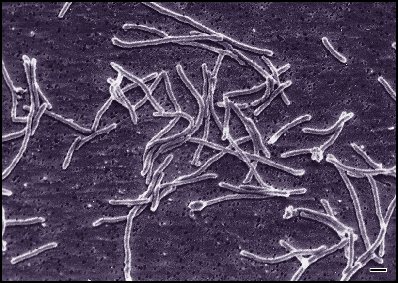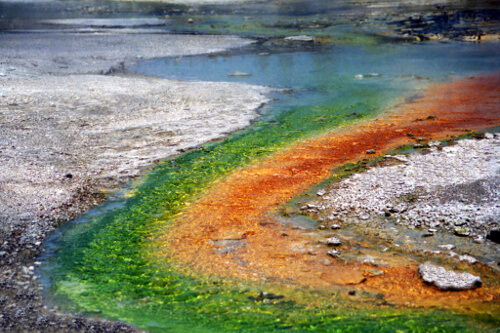Thermus aquaticus
by Camille Barr
Broadcast 2.21, 2.24, 2.25.2008

Thermus aquaticus, public domain image.
Listen:
Thermus aquaticus. An odd name that sounds like something out of a science fiction novel. Or perhaps a superhero that rescues people who have fallen to Davy Jones’ locker. It turns out that the name does belong to a superhero, but for reasons that will surprise you.
Thermus aquaticus is the scientific name for a bacterium that grows in hot springs. This bacterium was first discovered in 1969 at a place we’re probably all familiar with: Yellowstone National Park. If you’ve ever been there, you might remember the vibrant colors you can see at the hot springs. Those colors are actually the result of microorganisms like Thermus aquaticus. This single-celled organism lives best at 160 degrees Farenheit, which is 30 degrees hotter than what people thought at the time was the limit for life. Thermus aquaticus not only thrives at extremely high temperatures, it is also very ancient – in fact, its preference for extreme temperatures may be a holdover from when its ancestors lived in the hot and steamy environment of early earth.
When most organisms go above 130 degrees, the proteins in their cells change structure so that they become non-functional – just like how the protein in egg white changes when you cook it. Because proteins do almost everything that gets done in our cells, high temperatures are usually fatal. It was clear though, that Thermus aquaticus defied this destructive effect of heat, and this set off a rush to discover what these proteins were.
One of these proteins turned out to be very useful indeed.
Turn back the clock, to 1953. This was the year we learned the structure of DNA, which lit the fire for intense interest in the DNA of all organisms. What are genes? How do they differ between species? How do they differ between people? But because DNA is so small, to start studying it in depth, we needed to have more than we could get out of little cells. And this was a huge stumbling block for researchers. But in 1983, 30 years after the structure of DNA was discovered, a scientist named Kary Mullis discovered a method called the Polymerase Chain Reaction, or PCR, that did just that – it made millions of copies of the DNA that we can get out of cells. This was revolutionary, but there was a catch: this method required the DNA to be heated up to high temperatures, which destroyed all the proteins that are needed to copy the DNA.
And this is where Thermus aquaticus swooped in to save the day. Thermus aquaticus’ proteins are heat-stable. One of them, called Taq DNA polymerase, can keep copying DNA, even after being heated up. This allowed for the production of large quantities of DNA, which started a landslide into the study of our genes.
And the rest is history in the making. All because of this tiny organism, we have the human genome project. Because of this bacterium we have forensic DNA technology and CSI. Because of this bacterium we can grow rice that prevents blindness. And it is also because of this organism that we can determine whether or not we carry a gene for breast cancer, or a gene that makes us hate broccoli.
All this from an organism 500 times smaller than a grain of sand, happily thriving in the steaming pools of Yellowstone National Park. So next time you visit Old Faithful and the Upper Geyser Basin, take a look at the colorful water, and think about how this little superhero may one day help explain who you are.

Hot springs in Yellowstone National Park, photo by Brian W. Schaller (Free Art License 1.3).
Every week since 1991, Field Notes has inquired about Montana’s natural history. Field Notes are written by naturalists, students, and listeners about the puzzle-tree bark, eagle talons, woolly aphids, and giant puffballs of Western, Central and Southwestern Montana, and aired weekly on Montana Public Radio.
Click here to read and listen to more Field Notes. Field Notes is available as a podcast! Subscribe on iTunes, Google Play, or wherever you listen to podcasts.
Interested in writing a Field Note? Contact Allison De Jong, Field Notes editor, at adejong [at] montananaturalist [dot] org or 406.327.0405.
Want to learn more about our programs as well as fun natural history facts and seasonal phenology? Sign up for our e-newsletter! You can also become a member and get discounts on our programs as well as free reciprocal admission to 300+ science centers in North America!












